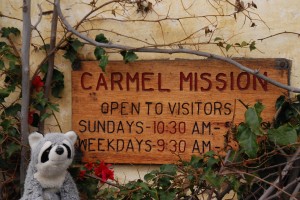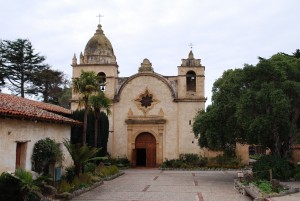Being a California kid, I first became acquainted with Fr. Junipero Serra almost as soon as I got to school. I’ve visited many of the missions, and many of them many times, especially San Carlos Borromeo in Carmel, California, which was Fr. Serra’s home base. And being a resident of the Left Coast, I also here fairly regularly about Fr. Serra’s sins, how he dragooned the local Indians* into living at the missions and prevented them from leaving, how he exploited their labor, how he forced Christianity on them, and how awful and evil and horribly non-post-Christian he was.
It is a fact that to be ignorant of history is to be doomed to saying dumb things.
There is some truth among the nasty things that are said. Fr. Serra and his followers did establish missions. They did invite the locals to become Christian; and as complex as the Catholic faith is, I can hardly think that the mission Indians knew what they were getting into. He did prevent those who’d been baptized from leaving the missions and going back to their old ways in manner that seems high-handed and paternalistic to us.
But it’s always dangerous to judge the actions of the men of one era by the standards of our own. Do we sympathize with their goals? Only sometimes. Would we approach the same goals in the same way? Probably not. But if we have virtues they lacked, and if we can see their flaws clearly, the opposite is also true. We have besetting sins they lacked, and much of what we think right and proper would horrify them—and rightly so.

It’s even more dangerous to leave out the historical context.
In Fr. Serra’s day, Alta California was a Spanish colony, and the colonists were coming. The California Indians were largely hunter/gatherers, requiring large ranges to support a small population, and those ranges were going to be divided up into ranchos and given to Spaniards. The locals were going to be pushed aside, or more likely exploited as labor. The hunter/gatherer way of life was doomed whether the missions came or not.
Now, let’s look at the goal of the missions. Each mission was, effectively, a rancho run by the Franciscan priests. But it was not simply a rancho. The intent was to teach these hunter/gatherers the modern skills they would need to live in a Spanish world: wood-working and iron-working and agriculture and all manner of things. More than that: it was never intended that the Franciscans would be in charge in the long term. Once the Indians were adept at the skills needed to keep things running, the missions were to be handed over to them. That is, they would eventually be ranchos, but owned by the Indians instead of by Spaniards. Looked at that way, the missions seem shockingly progressive.
This, incidentally, is why the missions were founded by the mendicant orders, Franciscans in Alta California and Dominicans in Baja California: the powers that be trusted them not to acquire the property for their own use, as the Benedictines might have.
And in time the missions were indeed secularized and given to the Indians. In the event the mission property rarely stayed in Indian hands for long; but you can’t blame the friars for that, as the timing was political rather than being based on the Indian’s readiness to take over, and there was no shortage of Europeans eager to beg, borrow, or steal the land from them. (But sometimes it worked out; I seem to recall learning, on my last trip to Carmel Mission, that some of the mission property remains in the hands of descendants of mission Indians to this day.)
In short, the goal of the missions was to protect the Indians from the Spanish settlers, not to enslave them. As an instance of this, I’ll note that Mission San Carlos Borromeo was first built in Monterey, next to the Presidio. Very shortly after, disgusted with the way the Spanish soldiers at the Presidio were treating the mission Indians, Fr. Serra moved the mission over the hill to Carmel.
And now for the big accusation: that the Indians were forced to become Christian.
Fr. Serra, a faithful Catholic, believed that the Catholic faith is objectively true, that it is an accurate description of the cosmos. He acted accordingly, in the belief that each human soul is a priceless treasure, and that to be Catholic, to receive the sacraments and the salvation of Jesus Christ, was objectively and undeniably better than not. As a faithful Catholic myself, I agree with him. I might say (I have to ponder this some more, as it’s a new thought for me) that to bring a person to Christ is a goal worthy of any or all measures consistent with the person’s dignity as a human being.
I (and, I think, the modern Church in general) might draw the line in a different place than Fr. Serra did. The mission Indians were certainly treated as children in some ways; and as I said above, I rather doubt that they really understood what they were getting into as they were taught about Christ and the words to say to receive baptism,
at least not at first. Once baptized, they were caught and brought back if they tried to leave the mission, and might be beaten; but the friars, on their part, saw them running from the sacraments and to their own perdition. And I also expect that any corporal punishment administered by the friars was mild compared to what went on at the secular ranchos.
In short, the mission Indians got a better deal from Fr. Serra than they would have gotten from anyone else in the vicinity; and they got the Truth of Christ as well. For my part, I’m eager to see Blessed Junipero join St. Francis Xavier on the roll of saints.
____
* I dislike the term “Native American” as it is commonly used. My ancestors on both sides came to the New World shortly after the Pilgrims. I have no relatives in Europe, no particular home land their, and no place to call my native soil but right here in Los Angeles. I have nowhere else to be a native of. The term “Indian” might not be politically correct, but you all knew what I meant.











